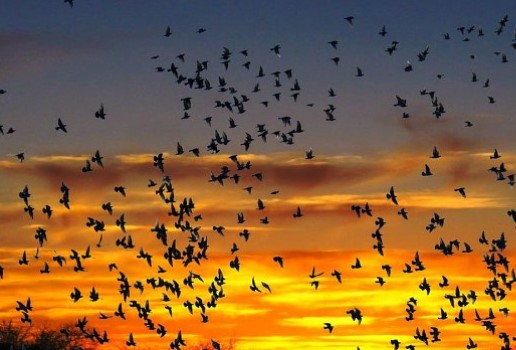Birds, those marvels of navigation, embark on incredible journeys across vast distances, relying on Earth’s magnetic field as their guiding compass. However, a lingering question persists: how does the periodic disruption of this magnetic field, triggered by solar flares and energetic outbursts, influence the reliability of these remarkable migratory systems?
Researchers from the University of Michigan set out to unravel this mystery, employing extensive datasets from Doppler weather radar stations and ground-based magnetometers. What emerged from their investigation was a revelation: a 9%-17% reduction in migrating bird numbers during severe space weather events, occurring in both spring and fall. Yet, the story took a more intricate turn—birds that did undertake migration during these events appeared to grapple with heightened challenges in navigation, particularly under overcast conditions in the autumn.
Published in Proceedings of the National Academy of Sciences, this study not only offers a unique perspective but uncovers previously unknown connections between geomagnetic disturbances and the dynamics of bird migration. Lead author Eric Gulson-Castillo emphasized the profound impact of environmental conditions, including imperceptible factors like geomagnetic disturbances, on shaping animal decisions and influencing population-level movement patterns.
The Earth’s magnetic field, a crucial component for these migratory journeys, is regularly influenced by solar outbursts that can trigger dazzling auroras and, occasionally, disrupt satellite communications, human navigation systems, and power grids. However, little was known about how these disturbances affect the animals that depend on Earth’s magnetic field for migratory orientation and navigation.
Unlike previous studies, which were often narrow in focus, both geographically and in the number of species examined, this research utilized a vast 23-year dataset of bird migration across the U.S. Great Plains—a major migratory corridor. The researchers harnessed the power of 37 NEXRAD radar stations in the central flyway of the U.S. Great Plains, analyzing over 1.7 million radar scans in the fall and 1.4 million in the spring.
The region chosen for this extensive study minimized influences from mountainous topography or coastlines, providing a clear canvas for understanding bird migration patterns. The community of nocturnally migrating birds in this region, predominantly composed of perching birds, shorebirds, and waterfowl, became the focal point of this intricate investigation.
The findings not only shed light on the challenges that birds face during severe space weather events but also underscore the delicate balance between environmental conditions and the intricate dance of migratory populations. As birds continue their extraordinary journeys, this research adds a new layer of understanding to the complexities of their navigational feats in a dynamic and ever-changing magnetic world.

The study harnessed the power of NEXRAD radar scans, capable of detecting groups of hundreds to thousands of migrating birds. These scans provided valuable insights into migration intensity—estimating the number of birds in each cluster—and the direction of flight. Concurrently, geomagnetic measurements were accessed through superMAG, a global network of geomagnetic ground stations, matching data from each radar station with a customized index of geomagnetic disturbance.
U-M space scientist Daniel Welling and former University of Texas at Arlington undergraduate Michelle Bui played pivotal roles in compiling and designing the geomagnetic disturbance index. Their efforts distilled years of ground magnetic field observations into a format suitable for the study, ensuring data quality and validation.
The researchers employed two complementary statistical models to measure the potential effects of magnetic disturbances on bird migration. These models factored in known variables such as weather conditions, temporal factors like time of night, and geographic elements like longitude and latitude.
Results pointed to a broad decrease in migration intensity during high geomagnetic disturbance, offering ecological context for decades of research on animal magnetoreception. Migrating birds, it seems, adapt their behavior during geomagnetic disturbances, with evidence suggesting increased drifting with the wind and reduced “effort flying” against crosswinds during cloudy skies.
Eric Gulson-Castillo, the study’s lead author, highlighted the implications: “Our results suggest that fewer birds migrate during strong geomagnetic disturbances and that migrating birds may experience more difficulty navigating, especially under overcast conditions in autumn. As a result, they may spend less effort actively navigating in flight and consequently fly in greater alignment with the wind.”
The collaborative effort involved researchers from various institutions, with support from grants and fellowships, including a University of Michigan MCubed grant, a National Science Foundation Graduate Research Fellowship Grant, and a Cornell Presidential Postdoctoral Fellowship, among others. The study adds a new layer of understanding to the intricate dance of migratory populations and their responses to dynamic environmental conditions.
